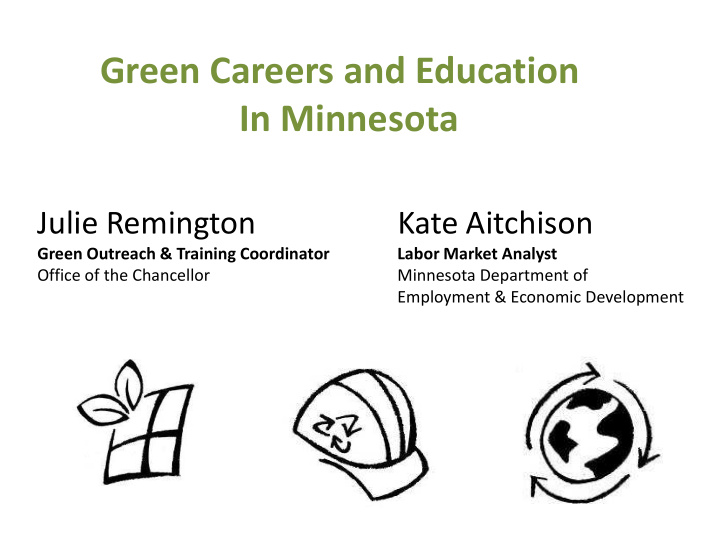



Green Careers and Education In Minnesota Julie Remington Kate Aitchison Green Outreach & Training Coordinator Labor Market Analyst Office of the Chancellor Minnesota Department of Employment & Economic Development
Background: In December 2009, DEED received a $1.15 million Labor Market Information Improvement grant from the U.S. Department of Labor Employment and Training Administration
The grant goals were to: • Study green jobs and training in Minnesota • Disseminate the findings to broad audiences, such as career changers, job seekers, dislocated workers, students, and career counselors.
The primary grant partners included: With involvement from many others: Minnesota State Colleges and University system Minnesota Department of Commerce Twin Cities RISE! Minnesota green employers and organizations Minnesota Career Information System
First, what is green? Green jobs have a direct or essential impact on a product, service, or process that results in environmental benefits. – An energy-efficient window is a green product because it helps save energy. – Water quality tests are green services because they help identify hazardous pollutants in lakes and streams. – Green processes involve creating more efficient ways of doing things through supply chain analysis or other techniques.
Grant projects and deliverables - Research study on green jobs - Green post-secondary programs identified - 50+ green career profiles - 20 green career videos - Online career pathway tools - Minnesota Green Careers website
Research Study on Green Jobs Period: Dec 2009 – May 2011 (four survey rounds) Methodology: Builds off Minnesota Job Vacancy Survey • Adds telephone interview on each potentially green job to: - confirm the environmental activities of each position. - gather qualitative information on skill and knowledge requirements, job duties, and hiring difficulty. • Adds in-depth interviews with key companies in key sectors.
Green Job Vacancies by Sector Overall, about 2.5% of job openings in Minnesota are green, totaling about 3,800 openings during the four survey rounds.
Regional Distribution of Green Job Vacancies* ...but proportionally the Central, Southwest and Northeast regions had the highest shares of green job vacancies. * Methodological limitations to regional comparisons
Distribution of Green Job Vacancies by Sector and Region, Fall 2009-Spring 2011
Green Job Vacancy Trends • 87% found within the private sector (75% corporation, 12% non-profit), 13% public sector • 66% found in companies with fewer than 50 employees, (compared to 39% of all vacancies) • 54% reported for newly created positions (rather than replacements)
Top 25 Green Vacancies Roofers HVAC and Refrigeration Mechanics and Installers Wind Turbine Service Technicians Environmental Engineers Marketing Managers First-Line Supervisors of Production and Operating Workers Sales Representatives, Technical and Scientific Products Electricians Production Workers, All Other (recycling and reclamation) Mechanical Engineers Bus Drivers, Transit and Intercity First-Line Supervisors/Managers of Retail Sales Workers Conservation Scientists Electrical Engineers Chemical Engineers Forest and Conservation Workers Environmental Scientists and Specialists Truck Drivers, Heavy and Tractor-Trailer Chemists Occupational Health and Safety Specialists Transportation, Storage, and Distribution Managers Landscaping and Groundskeeping Workers Mechanical Engineering Technicians Industrial Engineers Environmental Science and Protection Technicians 0 50 100 150 200 250
Educational Characteristics of Green Vacancies Education Categories Green Vacancies All Vacancies H.S./GED degree or less 37.0% 51% Vocational degree 22.0% 9% Associate’s degree 6.3% 6% 60% 35% Bachelor’s degree 32.0% 20% Advanced degree 2.5% 5% No response 0.2% 8%
Skills in Green Percent of Vacancies Example of how the skill is applied in practice requiring the skill Manage and schedule work for staff and 20% Supervising subcontractors Project Management 21% Development and implementation of land management plans for a small eco-region Analyze emissions data for greenhouse gas Mathematics 61% inventories 12% Technology design Design and test HVAC equipment for facilities or buildings. 69% Technical Redesign a manufacturing process to reduce waste; use specialized tools to diagnose and repair wind (operating and monitoring turbines. equipment, quality evaluation/testing, process and product design) Information Technology 3% Program computers and develop software for HVAC or smart grid systems.
Soft Skills in Green • Learning – life-long motivated learners • Communication – collaboration, interpersonal comm. • Problem Solving – combines creative thinking & technical knowledge • Persuasion – influence change, handle conflict
Additional Findings & Resources http://www.positivelyminnesota.com/Data_Publications/Data/Green_Jobs/ Green Occupations Green Industries Skills and Knowledge in Green Handouts, presentations Final report and other publications
Overview of completed grant projects and deliverables - Research study on green jobs - Green post-secondary programs identified - 50+ green career profiles - 20 green career videos - Online career path tools - Minnesota Green Careers website
Green Post-Secondary Program Inventory Offered in a print version, and online
Over 50 Green Career Profiles
20 Green Career Videos
Online (and Print) Career Pathway Tools
Minnesota Green Careers Website
Contact: Education & Career Information Questions Julie Remington Green Outreach & Training Coordinator Office of the Chancellor Julie.Remington@so.mnscu.edu Labor Market Information Questions Kate Aitchison Labor Market Analyst Minnesota Department of Employment & Economic Development Kate.Aitchison@state.mn.us
Recommend
More recommend